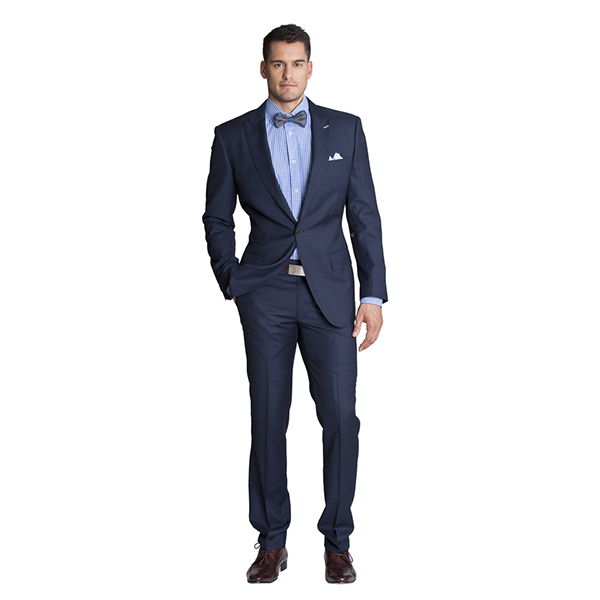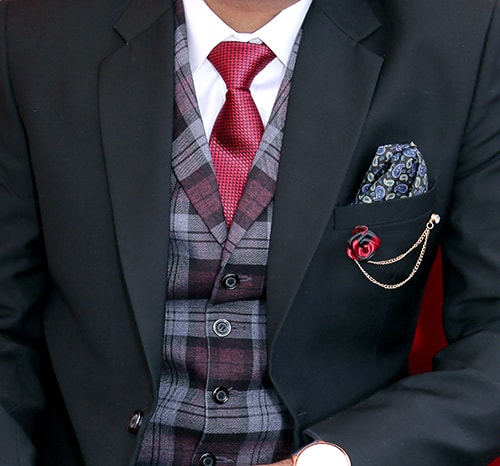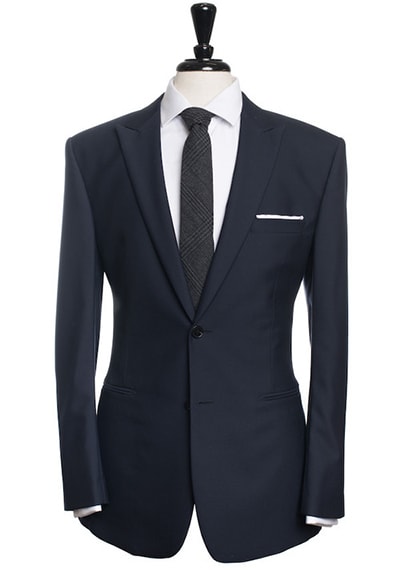Black and White Plaid Dress Suit With Hemmed Cuffes
The sartorial world of men's suits is a shape-shifting behemoth. Sometimes it's sleek and lustrous, other times it's nonchalant or a little bit rebellious. There's a suit style and type for every man. You just have to get through the messy jungle. With so many fits, styles, fashions and occasions to consider, it's easier said than done. So, we challenge you to define your own individual style! Our guide to suit basics will show you the way, and set you on the path to understanding the variety of design and stylistic choices available.

Types of Suit Fits
Slim Fit Suit

Joe Button Reda navy slim-fit suit
A slim fit suit is a prized possession in a man's arsenal. This style has the ability to trim away excess bulges without making you feel restricted. A slim fit flatters a masculine physique. By elongating the body, the legs appear longer. Tapering in at the waist, a slim fit suit makes the shoulders seem broader, highlighting a man's V-shaped torso. Just like the jacket, the trousers are close to the body and subtly tapered.
Super Slim/Skinny Fit Suit

ASOS
A super slim or skinny fit suit hugs the body closely by doing away with any and all excess fabric. It's a look that's fashionable but best suited to the more youthful, because it won't flatter bodies that have softened with age. When worn by a man with a slim and tall physique, a well-cut skinny suit draws the eye and creates a striking figure. To complete the look, the trousers are very narrow and tapered. Keep it immaculate by ensuring the pants fall just on the ankle, and no lower.
Regular/Classic Fit Suit

Lookastic
Hailing from Savile Row, this is the tailor's classic silhouette. Neither baggy nor skinny, a regular fit suit is undeniably traditional, but due to this nature, timeless. A quality suit will serve you well for decades. In this cut, emphasis is on a man's broad shoulder. The waist is shapely, without pinching in. There's room for movement in the back and also in the bicep area. Unlike the popular low-rise pants common today, trousers should sit on your waist. The legs will fall either straight or be subtly tapered at the ankle. This fit commonly features pants with a slight break.
Types of Suit Lapels
Notch Lapel

The notch lapel is the most common type of suit lapel, and is a classic for a good reason. Straddling both the traditional and contemporary, it's versatility means you can wear it to the office, cocktail party and beyond. You'll find the notch lapel on single-breasted suit jackets, sports jackets, blazers and coats. What width is preferred fluctuates with fashion trends. Never go out-of-style by choosing a lapel width proportional to your body size and importantly, shoulder width.
Peak Lapel

MawsonPhoto
A peak lapel instantly catches a viewer's eye and draws it upwards towards the shoulders. For the most flattering effect, peak lapels are commonly wider, and thus not only elongate your figure, but also accentuate your chest. Suits with peak lapels are bolder, sharp and attention-drawing while still classy. As such, it's a requisite component of the double-breasted suit style.
Shawl Lapel

Joe Button Sebastian navy tuxedo
Almost exclusively for tuxedos (also known as dinner jackets), a shawl lapel exudes elegance. This smooth curved lapel is usually a satin or grosgrain material, in either the same or contrasting colour as the jacket fabric. Generally, a skinnier lapel is considered "trendy" while a wider lapel has a classy appeal. However, it's not unheard of to see a shawl lapel on a blazer or sports jacket. This instantly catapults it into the opposite side of the spectrum - casual.
Types of Suit Styles
Single-Breasted Suit

Joe Button Belfort cobalt blue suit
The mainstay of the suiting world, single-breasted suits are ubiquitous. The single-breasted suit has one row of either one, two or three buttons. It's versatile and appropriate for a variety of occasions, from the office to weddings. When worn unbuttoned, this style of suit creates a narrower waist-slimming appearance thanks to its natural inward curve.
Tradition dictates some rules when it comes to buttoning:
The One-Button Jacket
- Button when standing and unbutton when sitting
The Two-Button Jacket
- Fasten the top button when standing and unbutton when sitting
The Three-Button Jacket
- Fastening the top button is optional, always button the middle button and never fasten the third
Double-Breasted Suit

Joe Button Rochester double-breasted suit with grey and blue windowpane
Updated by sleek tailoring, the double-breasted suit has shed its image as a stuffy, dated look from the 70s and 80s. The double-breasted suit generally has two rows of three buttons (six in total) where . By virtue of the extra row of buttons, it creates the illusion of a wider frame. As such, it favours leaner body types more than others. Peak lapels are de rigeur, adding further breadth to the figure and shoulders. Thus, this is a power item of clothing, for when you want to have a bit of swagger and make a statement. The double-breasted suit can be dressed up or down, making it suitable for both work and play. The rules to buttoning a double-breasted suit are:
The Two-Button Double-Breasted Suit Jacket
- Button (the one and only working button) at all times
The Four-Button Double-Breasted Suit Jacket
- Choose to button just the top, just the bottom or both working buttons. Unfasten the bottom button when sitting.
The Six-Button Double-Breasted Suit Jacket
- Fasten the bottom two buttons. However, for effortless suave, only button the middle one. Unfasten the bottom button when sitting.
Tuxedo Suit

Joe Button Henrik black tuxedo
A tuxedo is arguably the ultimate in menswear for expressing class, distinction and sophistication. Black tie, though not the most formal of dress codes, is typically reserved for events of great importance such as weddings and awards ceremonies. Black tie dictates a black or midnight blue tuxedo. What distinguishes a tuxedo from a suit is the presence of satin or grosgrain. Traditionally, the lapel, buttons and pocket trim have satin facing, and the trousers have a satin stripe down the side of the leg. The lapel can be either notch, peak or shawl, though the shawl lapel is the most elegant choice. A classic tuxedo jacket is single-breasted, has only one button, jetted pockets and a single centre vent.
For occasions that aren't so strictly formal, you can break away from black and go with colours such as maroon, slate blue or tan. The trousers also don't have to match the jacket.
Blazer

Joe Button royal blue blazer
You don't always have to buy the full ensemble of matching jacket and pants that comes as part of a suit. In fact, there are probably many occasions where you'd like to look dressed up but not as if you've just come from work. That's where a blazer comes in. A blazer is less formal than a suit jacket, which must be worn with its twinned pants, but more formal than a sports jacket. Cut looser, they have a more relaxed fit compared to a suit jacket. A dress shirt is optional, as blazers can be worn with a variety of other clothing, such as polo shirts or even T-shirts. Fabrics of a solid colour are typical.
Sports Jacket

Joe Button tweed plaid sports jacket
A sports jacket is like the fun uncle of the blazer family. Unrestricted by matching pants, pants of any fabric, colour and style are appropriate. Originally worn to play sports, a traditional sports jacket fits loosely - you could even wear a sweater underneath it. Owing to its rugged origins, sports jackets are commonly made of sturdier fabrics such as tweed. Once serving a functional purpose, elbow patches make an appearance too on sports jackets. They come in a variety of colours and patterns, with checks being an old time favourite. These days you'll find sports jackets of more delicate fabrics and a more fitted look, but the core characteristics remain. They're unrestricted by formalities and are able to take a beating.
Types of Suit Jacket Pockets
Flap Pockets

Joe Button Lyon bright electric blue suit
When thinking about the degree of formality of a suit, pockets play an important role. Flap pockets straddle the middle ground between casual and formal. Due to this versatility, it's the most common pocket type. Flap pockets are as equally appropriate for conservative business attire as for unfussy sports jackets. These pockets have a flap of fabric over the pocket opening. If you want, you can even tuck the flap in to create a makeshift jetted pocket and up your level of formality.
Jetted Pockets

Joe Button Logan dark navy suit
The jetted pocket is the most formal of pocket styles. All that can be seen of a jetted pocket is a thin trimming on the outside of the jacket. This lends the jacket a more clean and sleek, ideal for formal occasions that call for a perfectly tailored tuxedo . However, it's not restricted to just tuxedos. You'll also find jetted pockets on suits and blazers, for when its wearer wants to add an extra layer of formality. On suits and blazers, the trimming is of the same fabric as the jacket. On a tuxedo, the trim is of the same satin or grosgrain as the facing of the lapels of the jacket.
Patch Pockets

Joe Button light grey blazer with patch pockets
Unlike most pockets, which are hidden inside a garment, a patch pocket is essentially a pouch sewn onto the outside of the jacket. Patch pockets bring the formality of a jacket way down. As such, it's most commonly found on casual jackets such as a blazer or sports jacket.
Ticket Pocket

Joe Button Florrick blazer with ticket pocket
The ticket pocket is a smaller flap or jetted pocket usually located above the right main pocket on a man's jacket. It was in existence before railroads, but became popular thanks to the men who found it convenient to put their train ticket in its own dedicated pocket, saving them the trouble of searching through all of their pockets. Today the ticket pocket serves mostly an aesthetic purpose as a fashion statement. However, as it clutters up the front of the jacket, it brings a jacket closer into the casual territory.
Types of Suit Jacket Vents
Single Vent Suit Jacket

The purpose of the slit/s on the back of a jacket are threefold. First, it lets you sit without feeling constricted. Second, it helps to prevent the jacket fabric from bunching and wrinkling when you sit. Thirdly, it makes it easier for you to reach inside your trouser pockets. May we also add that it helps make your backside look good too?
A single vent on the centre of the back is the most mainstream. This means that it's more readily available off-the rack because it's cheaper to produce. It adequately serves the intended purpose, but is better suited for slimmer men who don't need too much extra room in the bottom half of the jacket. If you like putting your hands in your pockets, it's a good idea to steer away from single vents. Since the jacket splits down the very centre of your behind, it will part like a curtain when your hands are in your pockets, exposing that area.
Double Vent Suit Jacket

J.Crew Factory
Double-vented jackets have slits cut on both sides. Thanks to this, it allows for the most movement and the least bunching when you sit down. A well-tailored double-vented style sleekly follows a man's form. It tapers nicely through the waist and assists in a clean look from the front. Due to the vertical lines it creates along the back, it will also give the illusion of length and aid in slimming down wider physiques. However, as it requires more fabric and labour to create a double vented jacket, it can be more expensive to purchase.
No Vent Suit Jacket

J.Crew
The no-vent option is a popular Italian style. This look is elegant and quite figure-hugging, and suits slender, more petite frames. For men with a lean physique, it serves to highlight a small waist and broaden the shoulders. However, no vents mean restricted movement and less comfort when sitting. Moreover, the entire jacket will rumple up if you put your hands in your pockets.
Types of Suit Pants
Flat-Front Pants

Joe Button Maxim light grey dress pants
Flat-front pants offer a modern appeal, and are the standard among men's pants. As the name implies, the fabric lies flat at the front. It flatters men with leaner builds, as it's designed for a slim, tight fit. In line with the current trend, it looks good when worn mid- to low-rise. It's versatile too, and is just as fitting for casual as for formal occasions.
Pleated Pants

Tan double pleated dress pants | Macy's
Pleated pants are shaking off their fustiness, and making a comeback. The folds on the front of pleated pants create a more relaxed pair of trousers that are looser around the hips, but are still formal and neat. Unlike typical flat-front pants that perch on the hips, elongating your torso and shortening your legs, this style looks best when worn closer to your natural waistline, in a mid- to high-rise. This also avoids the fabric billowing out at the thighs. With more material around the hips and thighs, pleated pants are more comfortable to wear, especially for larger men or men who have thicker thighs that aren't accommodated by slimmer cuts.
Pleated pants come in two varieties: single or double. Single pleats are more subtle and blend into the centre crease (essential to suit pants). Double pleats offer more freedom of movement, which may be required by your body type.
Cuffed Pants

Joe Button dress pants with cuffs
Suit trousers will either be hemmed or cuffed. Hemmed pants have the bottom of the pant fabric turned up on the inside, whilst cuffed trousers have the fabric turned up on the outside. Hemmed pants are more commonly seen, as they're the default for the ever-popular flat-front pants. Pleated pants generally benefit from cuffs because the extra weight helps the pants drape more smoothly and look cleaner.
Cuffs are a stylistic choice that can make any outfit look sharper, but it's also worthwhile to consider whether cuffs will complement your body shape. Unlike hemmed pants which tend to elongate the legs, cuffed pants can make your legs look shorter. Tall men don't need to worry about this, so cuffs can easily look great. If you're on the shorter side and would like to wear pleated pants for their high-rise leg-lengthening effect, we recommend going with single pleats and hems. If instead you're on the stockier side and would like to wear pleated pants for their extra room, cuffs with double pleats will provide balance to your body.
Just keep in mind - no cuffs on tuxedo pants!
Now that you're better equipped with the knowledge and jargon of men's suiting, what are you waiting for? Go on out there and put your mark on the suiting world. What better way to venture into the foray than with a custom made-to-measure suit? At Joe Button , you'll be able to design a suit just the way you like it. Our expert stylists will guide you to choices that flatter and highlight the best of your physique. You'll cut a striking figure as king of the jungle.
Source: https://www.joebutton.com/style-advice/the-basic-guide-to-suit-styles-for-every-man/
0 Response to "Black and White Plaid Dress Suit With Hemmed Cuffes"
Post a Comment